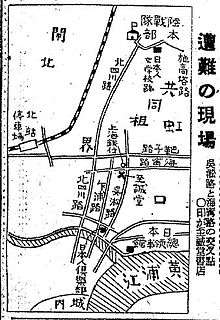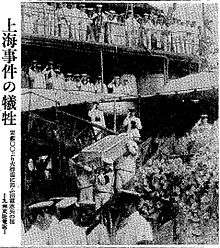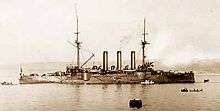Taminato incident

The Taminato incident (Japanese: Shanhai Nihonjin Suihei Sogeki Jiken (上海日本人水兵狙撃事件, "the Shanghai Japanese sailor sniping incident") was the murder of a Japanese sailor that took place in China's Hongkou District of the Shanghai International Settlement on 23 September 1936.[1] The Japanese government responded to the incident by occupying the Hankou District with a force of more than 2,000 soldiers, the largest Japanese troop presence in Shanghai since 1932, but the subsequent war scare with China did not escalate into a larger conflict.[2]
Background
In China at the time of the incident the anti-Japanese propaganda of the Chinese Communist Party was pervasive and the effects of this were continuing to spread. In 1935 the communists sought to augment their movement in favor of resistance against Japan through the August 1 Declaration and pro-Japanese sentiment in China was reaching a low point.[3]
Between 1935 and 1936 incidents involving Japanese people in China happened one after another and anti-Japanese sentiment even intensified into lethal terrorist acts such as the assassinations of a Japanese policeman in Shantou on 21 January 1935, a Japanese businessman in Shanghai on 10 July 1935, First Class Seaman Hideo Nakayama in Shanghai on 9 November 1935, businessman Kosaku Kayao in Shanghai on 10 July 1936, journalists Kozaburo Watanabe and Keiji Fukagawa in Chengdu on 24 August 1936, Japanese citizen Junzo Nakano in Beihai on 3 September 1936, and policeman Niwajiro Yoshioka in Hankou on 19 September 1936.[4][5]
The assassination

On 23 September 1936 four naval personnel from the crew of cruiser Izumo went ashore and were taking a walk on Haining Road in the Shanghai International Settlement. At 8:20 PM[6] when they approached the vicinity of its intersection with Wusong Road they were fired on from behind by four or five Chinese wielding pistols who were hiding in a stationary bus. The First-Class Seamen Tomomitsu Taminato and Yoshitane Yawata, as well as Second-Class Seaman Yoshimi Ideriha, sustained serious injuries.[1] After that the three wounded men were brought into Shiseido Bookstore but Taminato, who had received piercing bullet wounds to his left arm and right breast, collapsed onto the floor when trying to lean on a bookshelf and died immediately.[1]
Ensuing crisis
At about 8:30 PM the entire Hongkou District was put under martial law as 2,000 Japanese troops were sent into the streets to protect Japanese nationals and hunt down the perpetrators of the crime.[7] Roads were locked down and buildings searched.[8] At 11:30 PM an additional 100 Japanese soldiers were landed accompanied by tanks and armored vehicles[9] and by 12:00 AM the perimeter under their occupation began to extend outside Hongkou.[2] In accordance with the advice of the commander of Japan's 3rd Fleet,[6] Japan's response was more severe than it had been during the similar previous incidents in China,[7] and its deployment of a large landing party constituted the largest Japanese troop presence in Shanghai since 1932.[8] China was alarmed by the deployment and Chiang Kai-shek immediately asked War Minister He Yingqin by telegram to be in a state of war readiness.[1] Many Chinese civilians responded to the increase in tensions by fleeing the Hongkou District en masse.[10]
During the brief state of emergency the Japanese detained three suspects, all of whom were handed over to the Shanghai Municipal Police,[11] and on 25 September the majority of their soldiers withdrew to their barracks.[12] Even so, the Japanese landing party did not leave Shanghai and it re-occupied Hongkou on 1 October,[13] sparking a war scare as Chinese troops massed outside of Shanghai as well as a renewed refugee exodus as thousands more Chinese civilians fled the Japanese advance.[10][14][15]
Aftermath

The incident did not result in war, and in its wake other cases were resolved. On 2 October 1936 a Shanghai court sentenced two Chinese to death for their role in the killing of Hideo Nakayama in 1935[16] and the day following this verdict Japan withdrew its troops from Shanghai and the Chinese refugees began to return.[17] On 28 December a verdict in the Kosaku Kayao case was handed down in which two Chinese received the death penalty and five were given prison sentences.[18] Both of these cases as well as the murder of Taminato were linked to Wang Yaqiao, an anti-Japanese maverick known as the "king of assassins", who was himself assassinated on 21 November 1936.[19]
But while the Foreign Affairs Ministry strived through negotiations to protect Japanese nationals and maintain high standards for the administration of justice, they were not able to prevent further incidents, such as the assassination in Shanghai of Japanese sailor Yasuji Takase on 11 November 1936. Because of this the Japanese navy, which had been called upon during these crises in Shanghai and during the killing of Junzo Nakano in Beihai, felt a strong motivation to punish the Chinese which had an effect on the outbreak of the Second Sino-Japanese War and subsequent developments.[20] The Oyama incident on 9 August 1937 played a significant role in sparking the decisive Battle of Shanghai.
See also
References
- 1 2 3 4 Noboru Kojima, 日中戦争2 (Tokyo: Bungeishunju, 1984), 349-350.
- 1 2 "Crisis in China: 24 Dramatic Hours As Japan Occupied Part of Shanghai," New York Times, October 25, 1936.
- ↑ Shoichi Watanabe, 日本とシナ:1500年の真実 (Tokyo: PHP Institute, 2006), 209.
- ↑ Toshihiko Shimada, "Designs on North China, 1933-1937," in China Quagmire: Japan's Expansion on the Asian Continent, 1933-1941 , ed. James William Morley (New York: Columbia University Press, 1983), 179-192.
- ↑ Kumao Imoto, 支那事変作戦日誌 (Tokyo: Fuyo Shoten, 1998), 53.
- 1 2 Japan Diplomatic Correspondence Digital Archive, Showa Period II Set 1 Book 5 Volume 1 p.656-659, downloadable in the Japanese language at here
- 1 2 Hallett Abend, "Shanghai Area Occupied By Japanese Naval Force After Killing Of A Sailor," New York Times, September 24, 1936.
- 1 2 Hallett Abend, "Shanghai Tension Lessens," New York Times, September 25, 1936.
- ↑ "Japanese Declare Martial Law Over Big Shanghai Area," Christian Science Monitor, September 23, 1936.
- 1 2 Hallett Abend, "Shanghai Chinese Fleeing Japanese," New York Times, October 2, 1936.
- ↑ "Settlement Police Authority Usurped By Japanese," Times of India, September 26, 1936.
- ↑ Hallett Abend, "Japanese Reduce Force In Shanghai," New York Times, September 26, 1936.
- ↑ "Japanese Display Force In Shanghai," New York Times, October 1, 1936.
- ↑ "US Troops Take Up Arms As Shanghai's Fever Mounts," Washington Post, October 2, 1936.
- ↑ "Talk Of Blockade Of Yangtse Ports," Times of India, October 3, 1936.
- ↑ "Japan's Sentences On Chinese Renew Shanghai Tension," Christian Science Monitor, October 3, 1936.
- ↑ "Japanese Quit Shanghai Area; Tension Eased," Washington Post, October 4, 1936.
- ↑ Japan Diplomatic Correspondence Digital Archive, Showa Period II Set 1 Book 5 Volume 1 p.670, downloadable in the Japanese language at here
- ↑ Frederic Wakeman Jr., Spymaster: Dai Li and the Chinese Secret Service (Berkeley, California: University of California Press, 2003), 182-185, 460-461.
- ↑ David M. Gordon, "The China-Japan War, 1931-1945: Historiographical Essay," The Journal of Military History, January 2006, 147.
